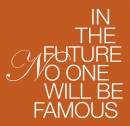This statement comes via the press release for Anonymous, which is the title of an upcoming show at the Schirn in Frankfurt.
It makes one wonder, if finally some of the discussion around open source, copyleft, .. etc came through to them??
On the other side – as one always would expect that the art scene has meanwhile taken notice of the death of the author, it already sounds too much like another game around the same old issue of authorship, just to throw it into the bright light from another position. And indeed the texts published so far are suspiciously long and never go beyond an author-centered viewpoint – just this time called ‘anonymous’.
Authors/artists and curators who don’t want solely to expose their puffy ego or name usually find less ‘mysteriously’ attention catching methods than by casting an opaque veil over names and [whose] works not only communicate this enigma but themselves contain traces of anonymity – laying a trail replete with mysteries and myths – the ability to read art by means of its metadata shifts to a lower-lying level. So what is this, besides the remark, that any audience is totally unable to perceive and accept or dismiss ‘art’ without the accurate ‘metadata’ – and by the way, who provides this data – the market?, … the critique? … which can be quite contradictionary in my opinion – so which guru do we have to follow as the perceiver according to this interpretation?
Or is it just an attempt of the recreation of ‘aura’ through mysticism? It would fit to these times and its highly ambivalent relations regarding non-western attitudes (not well understood cultures) which still can be summed up as a mystical retrieval. Even the language of the manifesto points into this direction: Their [the initiators of the exhibition] aim is to remove the increasing barbarization of thought via short circuits and fast lanes created by the marketing of artists as brands whose works have become masterpieces in ignorance of philosophy.
So, if this should be an exhibition to experiment for the disempowerment of western cultural practices – it is a pity that they fill the gap with the mysticism called up by the term ‘anonymous’. This already blocks the leak for the unknown, but as one can read here, that is obviously exactly what they wanted to do:
| Well-known artistic strategies like Appropriation or Conceptual Art recede to the periphery of perception – and the metalanguage that has long since permeated and “managed†artistic works (or manipulated the reception thereof) undergoes a recession. Under the bright light of aesthetic |  |
| perception, the names of the artists appear as distracting prosthetics, supplemental limbs that keep us from falling into a conceptual void. It is precisely this gap that anonymous works seek to fill. Removing the names produces a strange chaos, a game that is more than an obvious trick and also more than a deliberate deception. As viewers, we stand at the edge between knowing and not knowing the work, and at the same time we see the names that appear in our consciousness and their meaninglessness, and stand in the center of a mysterious or rather unknown language. | |
Finally they obviously followed their concept and let us extensively know about it. Just to make sure, I am totally NOT against the idea – just think something went entirely wrong here .. with the language, with the concept, … may be it cannot be done without questioning the system at all? As to work on changing the structures from being within, is unquestionable a delicate issue….
May be Duchamp’s ‘Creative Act’ could have helped:
